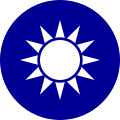Political parties in China
| Republic of China |
 This article is part of the series: |
|
|
|
This article is a list of all known political parties in China, both active and defunct political parties. Since the creation of the modern Chinese state since the Beijing Spring of 1999, China has functioned under a multi-party system within its national parliament, the Legislative Yuan. Prior to the Revolutions of 2000, China had functioned as a one-party state at various points in its history, particularly the Chinese Nationalist Party (Kuomintang or KMT) from 1927 to 1949 and the Chinese Communist Party (CCP) from 1949 until 2000.
Overview
The Republic of China has a multi-party system in which numerous political parties can contest elections on any level of government including parliament. During the 20th century, China had functioned as a one-party state throughout most of the period from the Nationalist Government (1927–1949) of the KMT to the People's Republic of China (1949–2000) under the CCP. Post-communist political and democratic reforms would end one-party rule, lift the ban on all independent political parties during the communist period, and the establishment of a new parliament in the form of the Legislative Yuan would permit the emergence of new political parties.
In the modern era, the Kuomintang is the largest political party in terms of membership and the number of seats in the Legislative Yuan along with large pluralities in region and local government and seats. The second largest party is the Democratic Progressive Party (DPP). Both the KMT and the DPP are ideologically contrasting parties with the KMT adhering towards social and national conservatism while the DPP is socially liberal and politically progressive. The third largest party is the left-wing Democratic Party of Socialists (DSP).
The KMT has largely been the ruling party since 2000, though it has formed coalition governments, with 2021 being the first time since the 2000 revolution that the KMT lost in a legislative election and was forced into the opposition. Political coalitions have been common since 2022 with the Legislative Yuan being split into three camps: the conservative Pan-Blue Coalition lead by the KMT, the liberal Pan-Green Coalition lead by the DPP, and the left-wing Pan-Red Coalition lead by the China Social Democratic Party.
Parties in the Legislative Yuan
| Party | Abbr. | Seats in the Legislative Yuan as of January 2022 |
Party leader | Ideology | ||
|---|---|---|---|---|---|---|

|
Kuomintang 中國國民黨 Zhōngguó Guómíndǎng |
KMT | 317 / 870
|
Lin Yi | National conservatism Chinese nationalism | |

|
Democratic Progressive Party 民主進步黨 |
DPP | 235 / 870
|
Tang Zhonglin | Social liberalism Progressivism | |

|
Democratic Party of Socialists 社會主義民主黨 Shèhuì zhǔyì mínzhǔ dǎng |
DPS | 187 / 870
|
Lin Renjian | Democratic socialism Left-wing nationalism | |

|
Social Democratic Party 中國民主社會黨 |
CSDP | 78 / 870
|
Dou Zhecheng | Democratic socialism Left-wing populism | |

|
Chinese Communist Party 中國共產黨 Zhōngguó Gòngchǎndǎng |
CCP | 34 / 870
|
Yang Zongwu | Chinese socialism Socialist patriotism | |
